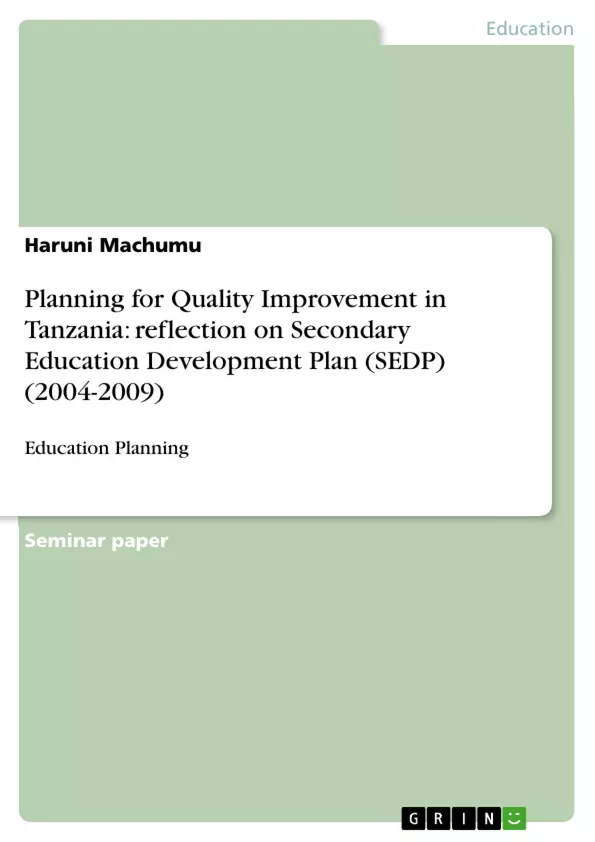This paper is about planning for quality improvement in Tanzania: reflection on secondary education development plan (SEDP). Quality education can be measured by establishing acceptable benchmarks and standards of good practice in planning, implementation and performance. The quality of education is a concept which would involve studying of the interaction between contextual factors, inputs, processes of teaching and learning as a means to realize its outcome. The main purpose of this paper is to examine how planning can be used/guide to improve quality of teaching and learning in secondary schools reflecting on SEDP aims, objectives, programme areas, challenges and governance. The situation of secondary education in actual is not well since there is a big shortage of qualified teachers, poor planning at local level (micro-planning), teaching and learning facilities, improper inspection, and the nature of students admitted; all these were addressed by SEDP document as a core programme areas.
Inhaltsverzeichnis (Table of Contents)
- Introduction
- Re-thinking Some Concepts in relation to SEDP and Education
- Quantitative Development Aspects in Education
- Quality Concern in education
Zielsetzung und Themenschwerpunkte (Objectives and Key Themes)
This paper examines how planning can be utilized to enhance the quality of teaching and learning in Tanzanian secondary schools, focusing on the Secondary Education Development Plan (SEDP) 2004-2009. It analyzes the SEDP's aims, objectives, program areas, challenges, and governance. The paper also explores the historical context of education in Tanzania, highlighting the country's transition from colonial rule to independence and the subsequent development of educational policies and initiatives.
- Quality Improvement in Secondary Education
- SEDP Planning and Implementation
- Quantitative and Qualitative Development in Education
- Challenges and Recommendations for Educational Planning
- Historical Context of Education in Tanzania
Zusammenfassung der Kapitel (Chapter Summaries)
- Introduction: This chapter sets the stage for the paper by providing a brief overview of the historical context of education in Tanzania. It highlights the colonial legacy and the country's post-independence efforts to establish a national educational philosophy. The chapter also introduces the Education Sector Development Programme (ESDP) and its two partner programmes, the Primary Education Development Programme (PEDP) and the Secondary Development Programme (SEDP). It further underscores the need for quality improvement in secondary education, citing challenges such as teacher shortages, poor planning, inadequate facilities, and limited access to education.
- Re-thinking Some Concepts in relation to SEDP and Education: This chapter explores key concepts related to education and development, including the role of education as an investment in creating an enabling environment for sustained change. It defines educational development as a systematic process of repackaging education to promote excellence and empower learners. The chapter also emphasizes the importance of sound policies and effective planning for achieving quality in education.
- Quantitative Development Aspects in Education: This chapter examines quantitative aspects of education development in Tanzania, focusing on the growth in student enrollment and the number of educational institutions from independence to 2010. It presents data on enrollment rates in pre-primary, primary, secondary, and higher education, highlighting the significant increase in access to education across all levels.
- Quality Concern in education: This chapter delves into the concept of quality in education, emphasizing the need for a sound planning department in each school and a data bank on educational indicators. It underscores the importance of educational planning in improving the lives of Tanzanians and achieving the goals of the Tanzania Development Vision 2025. The chapter concludes by quoting President Jakaya Kikwete's statement on the crucial role of quality education planning in building a strong and competitive economy.
Schlüsselwörter (Keywords)
The main keywords and focus topics of the text include: quality improvement, secondary education, Tanzania, SEDP (Secondary Education Development Plan), planning, development, education sector, access, enrollment, facilities, challenges, governance, historical context, colonialism, independence, educational philosophy, ESDP (Education Sector Development Programme), PEDP (Primary Education Development Programme), and quantitative and qualitative development.
- Quote paper
- Haruni Machumu (Author), 2011, Planning for Quality Improvement in Tanzania: reflection on Secondary Education Development Plan (SEDP) (2004-2009), Munich, GRIN Verlag, https://www.grin.com/document/179074



